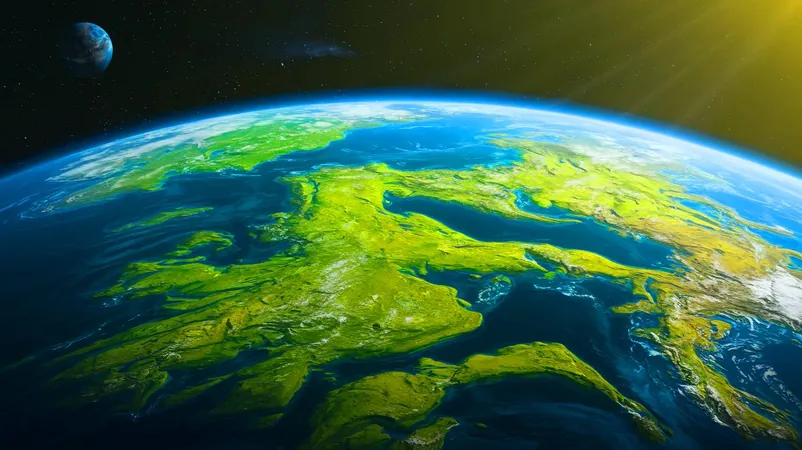
Earth's Oceans Were Once Green: A Shocking Discovery That Changes Everything!
2025-04-18
Author: Wei
Unveiling the Verdant Mystery of Ancient Oceans
A groundbreaking study from Japanese researchers has unveiled a stunning revelation about our planet's past: Earth's oceans were not always the deep blue we see today. Instead, evidence suggests they may have been a vibrant green hue around 3.8 billion years ago, reshaping our understanding of early Earth and the origins of life.
The Color of History: What the Research Shows
Published in the journal Nature, the study explores the water chemistry of the Earth's oceans during the Archaean eon, a pivotal time in our planet's evolution between 3.8 and 1.8 billion years ago. During this era, the atmosphere was devoid of the oxygen essential for most modern life, and single-celled organisms dominated.
Higher levels of iron in these ancient waters contributed to a radically different ecosystem, where early life forms thrived by harnessing energy through anaerobic photosynthesis, ultimately leading to the Great Oxidation Event, a monumental shift that paved the way for complex life forms.
How Green Was the Ocean?
Research shows that blue-green algae, or cyanobacteria, were thriving in these iron-rich waters, and their unique photosynthetic processes produced oxygen, transforming the atmosphere. The pigment phycoerythrobilin (PEB), found in these organisms, indicates that they prospered in green waters, supporting the theory of ancient oceans awash in shades of green.
A Deep Dive into Ancient Water Chemistry
The study led by scientists at Nagoya University connected the dots between ocean color and water chemistry. Observations around Iwo Jima, a volcanic island, revealed green-hued waters abundant in oxidized iron. This environment fostered the growth of blue-green algae, prompting researchers to rethink ancient marine conditions.
Through genetic engineering, researchers enhanced the growth rates of these algae in green waters, showing that the ancient ocean's chemistry played a crucial role in life's emergence.
What Does This Mean for the Future?
As studies into Earth's historical oceans evolve, fascinating theories about our planet's future arise. A recent study from Cornell University suggests that, as the sun ages, Earth's oceans may shift colors yet again, possibly transitioning to purple. This could signify dramatic changes in water chemistry and sunlight interaction over millennia.
Implications for Life Beyond Earth
This remarkable discovery concerning ancient green oceans doesn't just illuminate our past; it has profound implications for astrobiology. As scientists search for extraterrestrial life, ocean color could indicate biological activity, with certain pigments suggesting the existence of life in alien environments. Understanding these chemical variations is essential for identifying habitable zones and recognizing signs of life beyond our planet.
As we ponder the lush, green history of Earth’s oceans, we are reminded of the intricate interplay between chemistry, biology, and our ever-changing environment. This new knowledge challenges our perspective on the origins of life and fuels our curiosity for future discoveries that could revolutionize our understanding of life in the universe.


 Brasil (PT)
Brasil (PT)
 Canada (EN)
Canada (EN)
 Chile (ES)
Chile (ES)
 Česko (CS)
Česko (CS)
 대한민국 (KO)
대한민국 (KO)
 España (ES)
España (ES)
 France (FR)
France (FR)
 Hong Kong (EN)
Hong Kong (EN)
 Italia (IT)
Italia (IT)
 日本 (JA)
日本 (JA)
 Magyarország (HU)
Magyarország (HU)
 Norge (NO)
Norge (NO)
 Polska (PL)
Polska (PL)
 Schweiz (DE)
Schweiz (DE)
 Singapore (EN)
Singapore (EN)
 Sverige (SV)
Sverige (SV)
 Suomi (FI)
Suomi (FI)
 Türkiye (TR)
Türkiye (TR)
 الإمارات العربية المتحدة (AR)
الإمارات العربية المتحدة (AR)